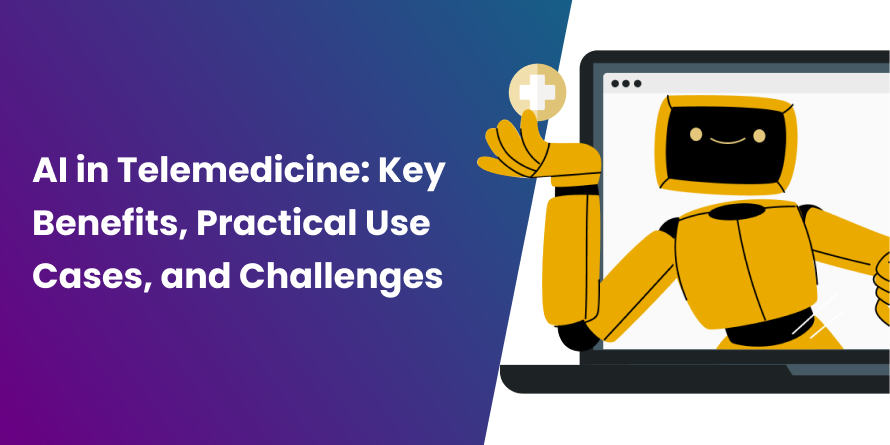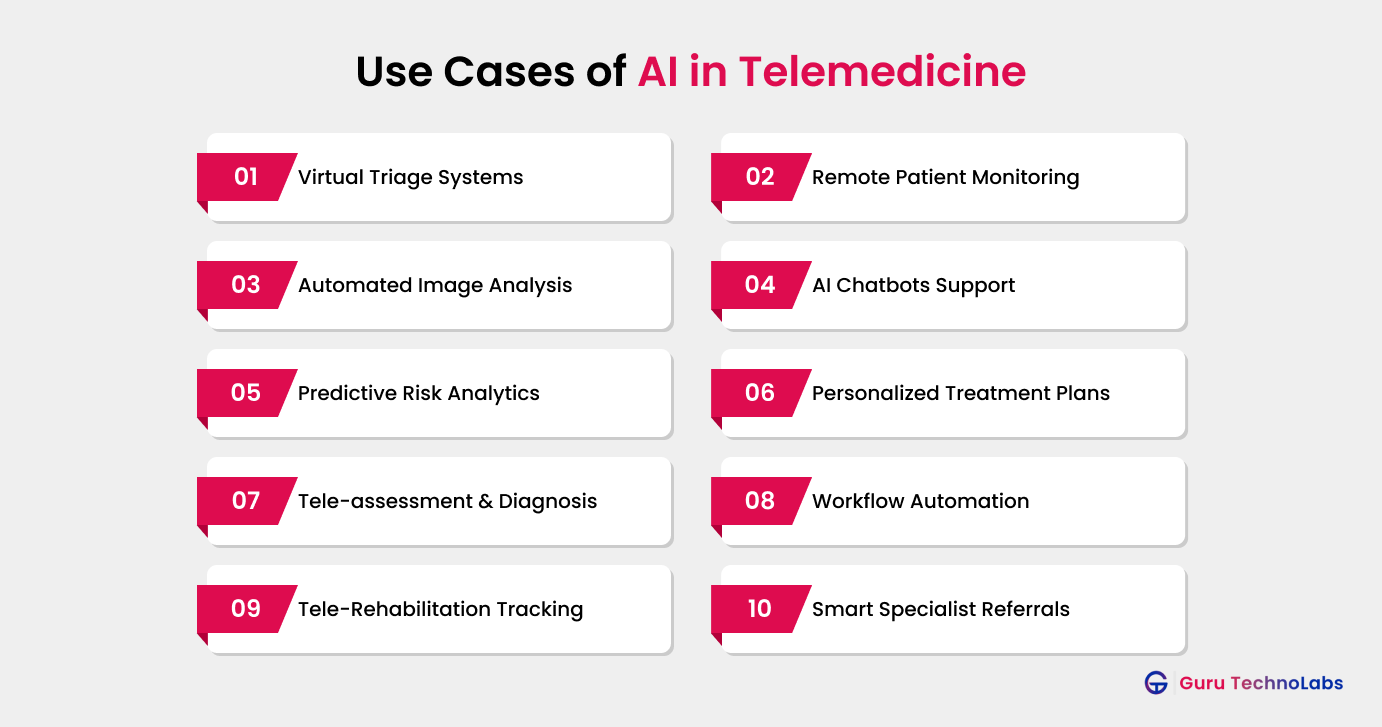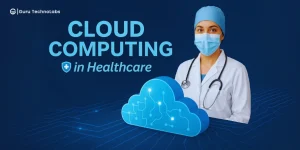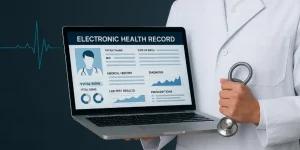AI in Telemedicine: Key Benefits, Practical Use Cases, and Challenges

Healthcare systems worldwide are under pressure: rising patient demand, a shortage of clinicians, and the growing expectation for 24/7 access to care. In this landscape, AI-powered telemedicine is emerging as a game-changer, making remote healthcare faster, smarter, and more accessible.
As of 2025, the global telemedicine market is projected to surpass $80 billion, with AI-driven solutions driving much of this growth. Adoption is accelerating rapidly: over 54% of Americans have used telehealth services, and physician use of AI jumped from 38% in 2023 to 66% in 2024, according to the American Medical Association.
Importantly, AI in telemedicine goes far beyond video consultations. It underpins real-time remote patient monitoring, powers virtual triage assistants, and enhances diagnostic imaging. Leading health systems like the Mayo Clinic have reported a 40% reduction in hospital readmissions through AI-enabled remote monitoring. Similarly, AI algorithms can now analyze medical images up to 30 times faster than traditional methods, with accuracy levels comparable to experienced radiologists.
What is Telemedicine?
Telemedicine refers to the delivery of healthcare services through digital communication technologies, allowing patients to receive diagnosis, treatment, and ongoing monitoring outside of traditional clinical settings. It represents a major shift in care delivery, breaking down geographical barriers and making quality healthcare more accessible than ever.
Unlike the common perception of telemedicine as just a video call with a doctor, modern virtual care platforms encompass a wide range of services, including:
- Clinical services – virtual consultations, AI-powered triage assistants, and digital diagnostic tools.
- Monitoring & follow-up – chronic disease management, remote patient monitoring (RPM), and post-surgical recovery tracking.
- Patient support – lifestyle coaching, medication reminders, and personalized health education.
Telemedicine offers particular value for:
- Patients with chronic conditions who require frequent check-ins.
- Rural and underserved populations with limited access to specialists.
- Individuals with mobility or transportation challenges who struggle to visit clinics in person.
The impact is measurable: studies show that telehealth adoption among rural patients has doubled since the pandemic, and regular virtual monitoring can reduce hospital admissions for chronic conditions by up to 30%.
How is AI Making a Difference in Telemedicine?
Artificial intelligence is reshaping telemedicine by making virtual healthcare smarter, faster, and more precise. As the demand for remote care continues to rise, AI empowers healthcare providers to deliver timely, data-driven treatment through features such as automated triage, real-time monitoring, and intelligent diagnostics.
Recent healthcare technology trends show that AI adoption in telehealth improves patient outcomes, enhances operational efficiency, and optimizes resource allocation.
For example:
- KardiaMobile uses AI to analyze ECG readings remotely, instantly alerting patients and doctors to potential arrhythmias.
- Ada Health’s AI chatbot guides patients through symptom checks, helping them make informed decisions and reducing unnecessary clinical visits.
These innovations not only strengthen patient engagement but also simplify telemedicine app for healthcare providers building comprehensive digital health platforms.
Here’s how the use of AI in telemedicine is making a difference:
1. Smart virtual triage prioritization
2. Real-time AI health monitoring
3. Rapid remote image diagnosis
4. Chatbots for patient support
5. Predictive, personalized care planning
6. Automated healthcare administration
With these advancements, AI in telemedicine is not just a trend – it’s a game-changer, driving the next wave of innovation in remote healthcare delivery.
The Benefits Of AI-Powered Telemedicine
With the rise of the adoption of cloud computing in healthcare, AI is making virtual care more precise, proactive, and accessible than ever before. From real-time diagnostics to seamless patient engagement, the integration of AI is reshaping the way patients and providers experience telemedicine.
Instant, Accurate Diagnostics
AI can analyze medical images and patient data in real-time, providing rapid and highly accurate diagnoses, even in remote settings. This reduces diagnostic errors and speeds up treatment decisions, as seen with platforms that use AI to flag strokes or other critical conditions instantly.
Proactive Remote Patient Monitoring
By connecting wearables and smart devices, AI continually tracks vital signs and health patterns, alerting providers to early warning signs before issues escalate.
Personalized Treatment Recommendations
AI sifts through genetic, lifestyle, and clinical data to create tailored care plans, ensuring each patient receives the most effective therapies for their unique needs.
Enhanced Mental Health Support
AI-powered chatbots and virtual therapists offer 24/7 mental health check-ins, detect behavioral changes, and provide coping strategies, making ongoing support accessible to more people, especially between appointments.
Streamlined Administrative Processes
Automation through AI handles scheduling, billing, and documentation, reducing human error and freeing up clinicians to focus on patient care.
Predictive Analytics for Preventive Care
AI analyzes historical and real-time data to forecast health risks, enabling clinicians to intervene early and prevent complications. This predictive power is transforming remote care from reactive to preventive.
Expanded Access to Specialist Care
Through AI-driven triage and smart referrals, patients can connect with the right specialists faster, regardless of their location.
Use Cases of AI in Telemedicine

1. Virtual Triage Systems
At leading institutions like the Cleveland Clinic, these systems now achieve up to 94% & diagnostic accuracy by using advanced machine learning to analyze patient symptoms and medical histories in real-time.
The AI asks targeted questions, evaluates risk factors, and recommends the best care pathway – whether that’s self-care, a virtual consultant, or urgent in-person evaluation.
This not only speeds up care for critical cases but also reduces unnecessary clinic visits and wait times, making healthcare more efficient and accessible for everyone.
2. Remote Patient Monitoring
AI-driven remote monitoring leverages wearables and IoT devices to continually track vital signs such as heart rate, blood oxygen, and glucose levels.
These systems analyze real-time health data, flagging early warning signs and enabling healthcare providers to intervene before conditions worsen.
This dynamic approach is particularly valuable for chronic disease management, as it reduces hospital readmissions and supports patients in maintaining their health at home. With AI interpreting the data, clinicians can focus on patients who need attention most, while patients enjoy greater peace of mind and convenience.
3. Automated Image Analysis
Automated image analysis with AI is redefining diagnostics in telemedicine. AI algorithms can interpret X-rays, MRIs, and CT scans remotely, often delivering results in seconds and with accuracy that matches or exceeds human experts.
For example, during the pandemic, AI tools like those from Infervision and Quare.ai helped radiologists rapidly detect pneumonia in chest scans, enabling faster treatment decisions.
These systems not only speed up diagnosis for remote patients but also help reduce diagnostic errors, making advanced care available even on a resource-limited budget.
4. AI Chatbots Support
Chatbot support is transforming patient engagement by offering instant responses to medical queries, appointment scheduling, and medication reminders.
These intelligent assistants can triage symptoms, provide health education, and direct patients to appropriate care resources, improving both accessibility and efficiency in healthcare communication.
Advanced chatbots are redefining how patients interact with healthcare providers online. These intelligent virtual assistants are capable of:
- Conducting symptom checks using natural language processing (NLP)
- Answering frequently asked health queries
- Booking or rescheduling appointments
- Sending medication reminders and follow-ups
-
The benefit? They are available 24/7 and can support multiple languages, making healthcare more inclusive and accessible.
AI chatbots reduce the burden on medical staff by handling routine interactions, allowing clinicians to focus on complex patient needs. This also reduces patient wait times and improves the overall telehealth experience.
5. Predictive Risk Analytics
One of the most groundbreaking uses of AI in telemedicine is predictive analysis. AI algorithms can assess large volumes of structured and unstructured data, from electronic health records (EHRs) to wearable device metrics, to predict the likelihood of:
- Stroke or heart attack
- Hospital readmissions
- Complications in chronic diseases like diabetes or COPD
These insights help clinicians intervene early, often before symptoms escalate. Much of this intelligence is born from generative AI development, where models are trained to recognize patterns and anomalies that human predictors might miss. This is not only a game-changer in critical care but also a step toward a more proactive healthcare system.
6. Personalized Treatment Plans
Gone are the days of one-size-fits-all medicines. With AI, treatment plans can be hyper-personalized based on:
- Genetic data and family history
- Lifestyle and behavioral factors
- Response to previous treatments
AI systems can recommend medication types, dosages, and even diet plans customized to the individual. These dynamic treatment paths are adjusted in real time based on incoming patient data, especially useful for long-term care in telemedicine settings.
Patients with chronic illness or undergoing complex therapies like cancer treatment can now receive care that’s adaptive, continuous, and closely monitored from their homes.
7. Tele-assessment & Diagnosis
AI is evolving how diagnoses are performed in virtual settings. Using technologies like image recognition, voice analysis, and NLP, AI can:
- Detect skin conditions via photo uploads
- Identify respiratory issues by analyzing cough sounds
- Evaluate mental health by interpreting speech tone and facial cues
This diagnostic power is further amplified by IoT in healthcare – devices such as smart thermometers, glucometers, and pulse oximeters stream real-time health metrics to doctors, allowing AI to cross-reference symptoms with vitals and make fast, reliable recommendations.
In rural and underserved regions, AI-driven assessments bridge the care gap, giving patients access to quality diagnostics without needing to travel.
8. Workflow Automation
Administrative overload is a major source of burnout for healthcare professionals. AI reduces this burden significantly by automating routine and repetitive tasks. Here’s how:
- AI schedules patient appointments and sends automated reminders
- It processes insurance claims and billing codes with minimal human intervention
- Virtual assistants transcribe medical notes and update patient records in EHRs
Clinics and health startups aiming to develop such automation tools want to work with a dedicated development team to ensure robust backend systems, healthcare regulation compliance, and seamless integration with existing platforms.
9. Tele-Rehabilitation Tracking
For patients recovering from surgeries, strokes, or physical injuries, rehabilitation can now continue from home, thanks to AI and motion-tracking technologies. AI can:
- Monitor patients’ movements using computer vision during virtual rehab sessions
- Score performance and detect improper posture or form
- Suggest real-time corrections to prevent reinjury
These systems also generate progress reports for therapists and physicians to track healing and modify rehab plans as needed. The convenience of tele-rehab also increases patient adherence, leading to better long-term outcomes.
10. Smart Specialist Referrals
Referral delays are a significant bottleneck in traditional healthcare. AI systems in telemedicine platforms can:
- Analyze the patient’s symptoms and medical history
- Predict like diagnoses
- Automatically route patients to specialists based on availability, specialization, and location
This intelligent referral process eliminates unnecessary touchpoints and ensures timely, targeted care. It also improves clinical outcomes and reduces overall healthcare costs.
Challenges and Considerations in Implementing AI in Telemedicine
While combining AI with telemedicine brings many benefits, there are still a few key challenges that need to be addressed to ensure safe, fair, and effective care.
Protecting Patient Data
Telehealth handles sensitive medical information, so protecting patient privacy is critical. These services must follow strict guidelines, like HIPAA regulations, to keep data safe during storage and transfer.
Strong cybersecurity measures are needed to prevent data leaks, and cyberattacks and to ensure patients’ trust is maintained.
Following Legal and Regulatory Rules
Telemedicine services must meet various legal and professional requirements. These include proper licensing of doctors, verifying credentials, and obtaining certifications from healthcare authorities.
Platforms also need to follow federal and state laws that govern how telemedicine should be practiced to make sure care remains safe and reliable.
Keeping the Human Connection Alive
AI-powered healthcare can be efficient, but it should not replace the personal connection between doctors and patients. People still value real conversations, empathy, and reassurance from their healthcare providers.
To keep that human touch, telemedicine platforms can use tools like video calls, virtual assistants, and chat features to make the experience feel more personal.
Bridging the Technology Gap
Not everyone has equal access to the internet or smart devices. For telemedicine to truly help everyone, it must also address the digital divide. That means making sure people have access to high-speed internet, smartphones, or computers, and know how to use them.
Without this, many could be left out of the benefits of AI-driven care.
Future Of AI in Telemedicine
In today’s era, where innovation meets convenience, AI is redefining telemedicine, making healthcare truly centered around the patient. The hassle of traveling long distances and sitting in packed waiting areas is now a thing of the past – quality medical care is available at your fingertips.
Thanks to AI-driven solutions, cloud technology, and IoT networks, telehealth is reshaping the way we connect with healthcare professionals. As artificial intelligence in healthcare continues to evolve, the future promises smarter, quicker, and more accessible care for everyone.
No more battling traffic or spending hours in waiting rooms; your smartphone is now your gateway to expert medical advice, prioritizing comfort and efficiency. All you need is the right telemedicine app development company to turn your digital healthcare vision into reality.
By partnering with the AI Development team, you can create an AI-powered platform that delivers instant consultations, precise diagnoses, and superior patient experiences – all from the convenience of home.
Frequently Asked Questions
AI in telemedicine uses smart algorithms to assist in virtual care tasks like diagnosis, monitoring, and treatment planning.
AI helps by analyzing patient data, suggesting treatment options, and automating tasks like note-taking during virtual visits.
No. AI supports the process, but licensed healthcare providers make the final diagnosis and treatment decisions.
Key issues include data privacy, regulatory compliance, lack of personal touch, and unequal tech access.
Yes, it reduces long-term costs by automating tasks, improving accuracy, and avoiding unnecessary visits.
No. AI assists doctors but doesn’t replace their clinical expertise or human connection with patients.



















